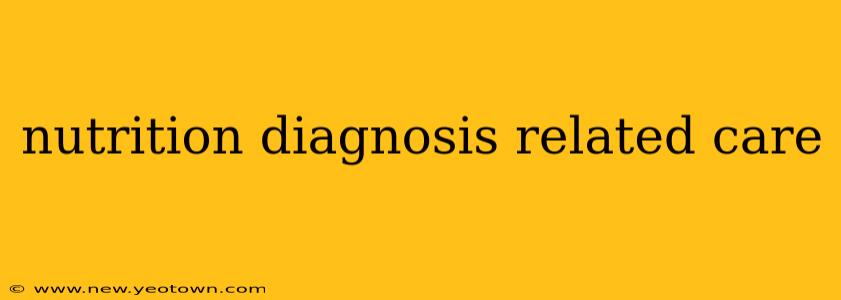Imagine a world where healthcare focuses solely on treating symptoms, ignoring the root causes of illness. That's a world without nutrition diagnosis. This critical component of healthcare goes beyond simply recommending a "healthy diet." It delves into the intricate relationship between food, nutrients, and a person's overall health, uncovering nutritional deficiencies and imbalances that contribute to disease and hinder recovery. This isn't just about counting calories; it's about understanding the body's unique nutritional needs and crafting personalized interventions.
Let's embark on a journey into the world of nutrition diagnosis, exploring its vital role and answering some key questions that frequently arise.
What is Nutrition Diagnosis?
Nutrition diagnosis is the cornerstone of a registered dietitian's (RD) or registered dietitian nutritionist's (RDN) work. It's a systematic process of identifying and labeling an individual's nutritional problems. Think of it as a detective's investigation, meticulously gathering clues—medical history, dietary intake, physical examination findings, and laboratory data—to pinpoint the nutritional culprits affecting a person's health. This careful assessment allows the development of a personalized care plan to address those issues effectively. It's about more than just identifying a deficiency; it's about understanding why that deficiency exists and what factors contribute to it.
What are the different types of nutrition diagnoses?
Nutrition diagnoses are categorized into three domains by the Academy of Nutrition and Dietetics:
-
Intake: This domain focuses on actual or potential problems with the intake of energy, nutrients, fluids, or other dietary components. For example, a diagnosis might be "insufficient energy intake" or "excessive saturated fat intake."
-
Clinical: This domain addresses medical or physical conditions that influence or are influenced by nutritional factors. Examples include "swallowing difficulty" (dysphagia), which can impact nutrient intake, or "overweight," which is linked to various health issues.
-
Behavioral-environmental: This domain examines individual knowledge, attitudes, beliefs, and behaviors related to food and nutrition, along with environmental factors that influence food choices and access. Examples include "limited access to healthy food choices" or "unrealistic body image."
Understanding these domains is crucial for creating a comprehensive plan that addresses not just the symptoms but also the underlying behaviors and environmental factors that impact a person's nutritional status.
How is a nutrition diagnosis made?
The process of making a nutrition diagnosis is a systematic and evidence-based approach. It typically involves these steps:
-
Assessment: This involves gathering data through various methods, including medical history reviews, dietary assessments (food diaries, 24-hour recalls), anthropometric measurements (height, weight, BMI), biochemical data (lab results), and physical examinations.
-
Diagnosis: Based on the assessment data, the RD/RDN analyzes the information and identifies the nutrition problem. This involves choosing the appropriate diagnostic terminology from standardized language like the Academy of Nutrition and Dietetics' standardized language.
-
Intervention: Once the diagnosis is established, an individualized care plan is created focusing on the specific identified problems. This plan may include nutrition education, medical nutrition therapy (MNT), counseling, or referral to other healthcare professionals.
-
Monitoring and Evaluation: The plan's effectiveness is continuously monitored and evaluated, with adjustments made as needed based on progress and any new information.
What are the benefits of nutrition diagnosis?
The benefits of nutrition diagnosis are far-reaching and profoundly impact overall health outcomes. By accurately identifying nutritional issues, healthcare professionals can:
-
Improve disease management: Effective management of chronic diseases like diabetes, heart disease, and kidney disease relies heavily on appropriate nutrition therapy.
-
Enhance recovery: Nutritional support is vital for recovery from illness, injury, or surgery. Tailored plans optimize healing and reduce complications.
-
Prevent disease: By addressing potential nutritional risks early on, many health problems can be prevented.
-
Improve quality of life: Addressing nutritional deficiencies and imbalances can significantly improve energy levels, mood, and overall well-being.
What are some common nutrition diagnoses?
Some of the most common nutrition diagnoses encompass a wide spectrum of conditions, from simple deficiencies to complex medical issues. These can include:
-
Inadequate protein intake: Essential for building and repairing tissues.
-
Iron deficiency anemia: Results from insufficient iron intake or absorption.
-
Vitamin D deficiency: Associated with increased risk of bone fractures and other health problems.
-
Obesity: A state of excessive body fat, contributing to various health risks.
-
Malnutrition: A broad term encompassing various nutritional imbalances.
This comprehensive approach ensures that individuals receive targeted and effective interventions, leading to improved health outcomes and a higher quality of life. Nutrition diagnosis is not merely a dietary recommendation; it is a vital diagnostic tool in modern healthcare, offering personalized, evidence-based care that addresses the unique nutritional needs of each individual.

